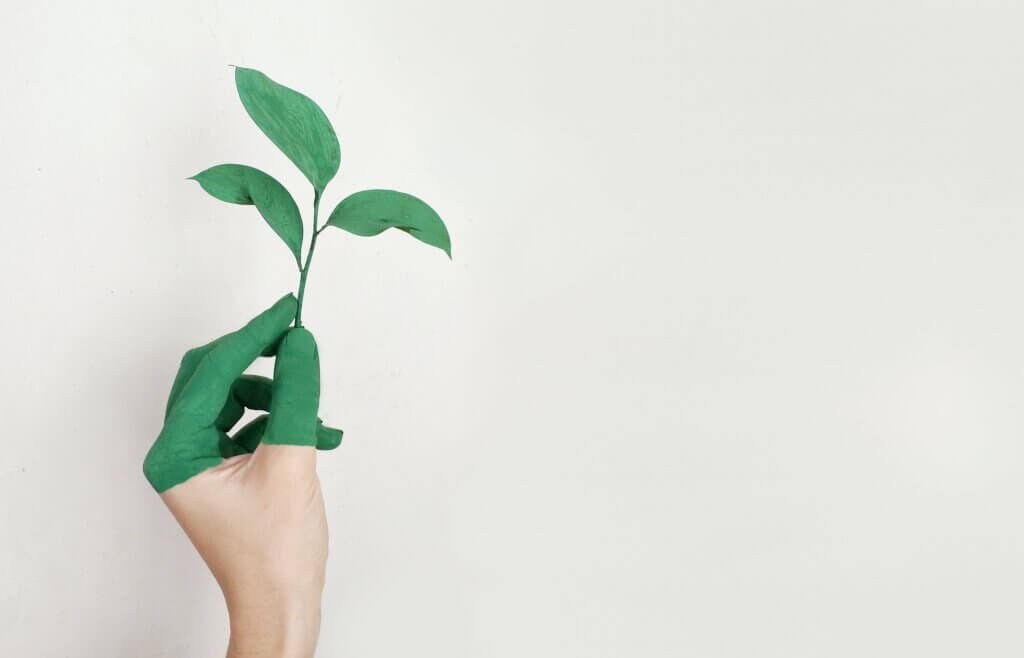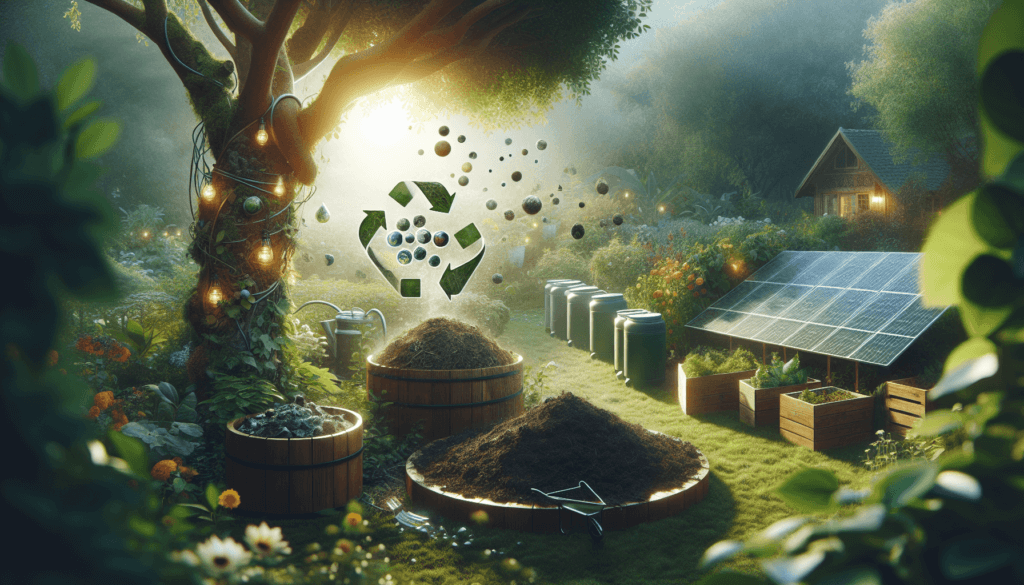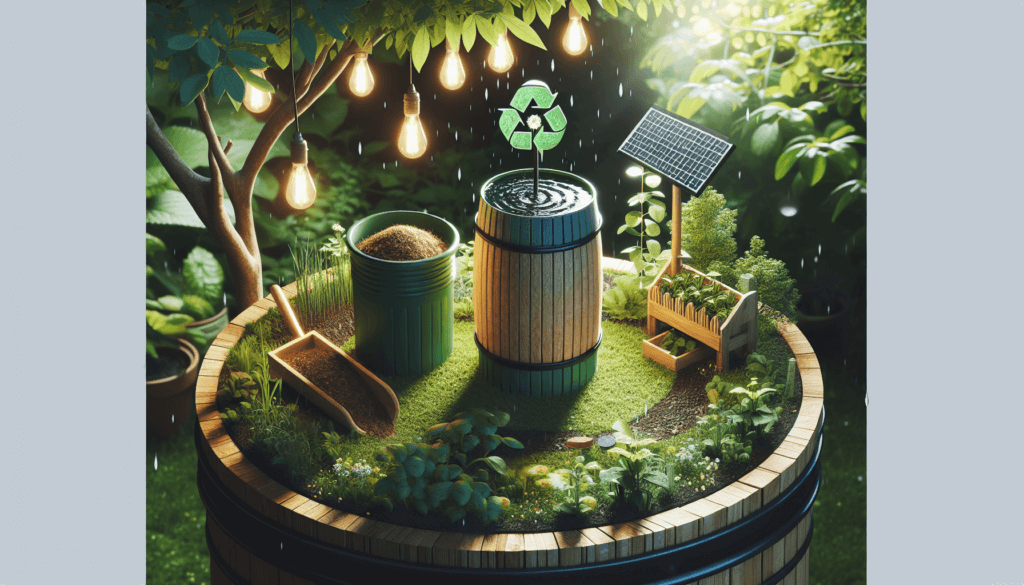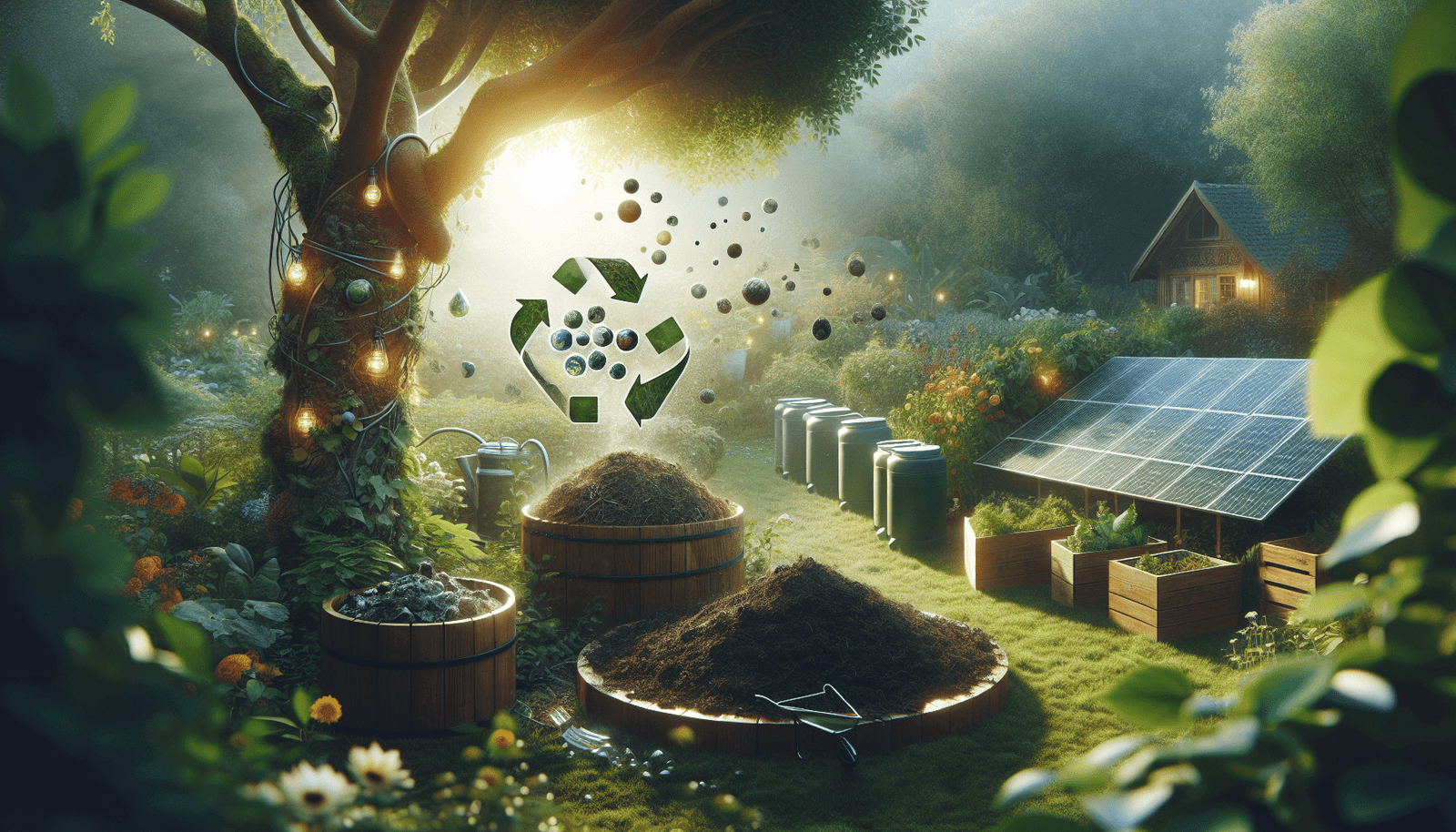When it comes to making your garden more sustainable, using renewable resources is a fantastic way to reduce your environmental impact while creating a beautiful and thriving outdoor space. From composting and rainwater harvesting to utilizing natural pest control methods, there are countless ways to incorporate renewable resources into your gardening practices. In this article, we will explore some simple yet effective ways to maximize the use of renewable resources in your garden, allowing you to not only minimize waste but also promote a healthier ecosystem for you and your plants to enjoy.
1. Benefits of Using Renewable Resources
Reduces environmental impact
Using renewable resources in your garden can significantly reduce your environmental impact. Unlike non-renewable resources, such as fossil fuels, renewable resources are continually replenished and don’t contribute to greenhouse gas emissions or air pollution. By utilizing renewable resources, you are taking a proactive step towards mitigating climate change and protecting the environment for future generations.
Conserves natural resources
Renewable resources, as the name suggests, are renewable and abundant in nature. They provide a sustainable alternative to depleting natural resources, such as water and fossil fuels. By opting for renewable resources in your garden, you are conserving these valuable natural resources and ensuring their availability for years to come.
Improves soil health
Another significant benefit of using renewable resources in your garden is the improvement of soil health. Organic materials, such as compost and mulch (which we will discuss later in this article), add valuable nutrients to the soil, enhancing its fertility and structure. By incorporating renewable resources into your garden practices, you can create a healthier and more productive growing environment for your plants.
2. Types of Renewable Resources
1. Organic materials
Organic materials, such as kitchen scraps, yard trimmings, and fallen leaves, are excellent sources of renewable resources for your garden. These materials can be composted to create nutrient-rich organic matter that can be used as a natural fertilizer for your plants. Composting not only reduces waste sent to landfills but also helps improve soil health and moisture retention.
2. Rainwater harvesting
Rainwater harvesting is an effective way to utilize a renewable resource in your garden. By collecting rainwater, you can reduce your dependence on water provided by municipal sources, which often require energy for purification and transportation. Rainwater can be stored in barrels or underground tanks and used for watering your plants, reducing your water bills and conserving this precious resource.
3. Solar power
Harnessing solar power is another fantastic way to utilize renewable resources in your garden. Solar panels can be installed to power garden lights, water pumps, and other devices, eliminating the need for electricity derived from non-renewable sources. By using solar power, you not only reduce your carbon footprint but also save money on energy costs in the long run.

3. Composting
What is composting?
Composting is the process of decomposing organic materials, such as food scraps, yard waste, and paper, into nutrient-rich compost. Composting can be done in a designated compost bin or pile, where microorganisms break down the materials over time. The resulting compost can be used as a natural fertilizer for your garden, providing essential nutrients to your plants and improving soil health.
Benefits of composting
Composting offers numerous benefits for your garden. First and foremost, it reduces the amount of organic waste sent to landfills, minimizing greenhouse gas emissions and methane production. Additionally, compost improves soil structure, moisture retention, and nutrient availability, resulting in healthier plants and increased yields. By composting, you are closing the nutrient loop and promoting a sustainable, eco-friendly garden ecosystem.
How to start composting in your garden
Starting composting in your garden is relatively easy. Begin by choosing a suitable composting system, such as a compost bin or a compost heap. Then, collect organic materials such as fruit and vegetable scraps, coffee grounds, grass clippings, leaves, and shredded paper. Layer these materials in your compost bin, ensuring a good balance between “green” (nitrogen-rich) and “brown” (carbon-rich) materials. Turn the pile occasionally to aerate it and speed up the decomposition process. In a matter of months, you will have nutrient-rich compost ready to use in your garden.
4. Mulching
Advantages of mulching
Mulching is the practice of covering the soil surface around your plants with a layer of organic or inorganic material. This protective layer offers several advantages for your garden. First, mulch helps conserve soil moisture, reducing the need for frequent watering and preventing water loss through evaporation. Additionally, mulch acts as insulation, regulating soil temperature and protecting plant roots from extreme heat or cold. Moreover, mulching inhibits the growth of weeds, minimizing competition for nutrients and sunlight.
Different types of mulch
There are various types of mulch that you can choose from for your garden. Organic mulches include materials like wood chips, straw, grass clippings, and shredded leaves. These organic mulches break down over time, adding valuable organic matter to the soil. Inorganic mulches, such as gravel, stone, or landscape fabric, provide a long-lasting option that doesn’t degrade but still offers weed suppression and moisture retention benefits.
Applying mulch in your garden
To apply mulch in your garden, start by preparing the soil surface by removing weeds and leveling the area. Then, spread a layer of mulch around your plants, ensuring a thickness of 2-3 inches. Leave a small gap around the plant stems to prevent moisture buildup and potential rotting. As the organic mulch decomposes, replenish it periodically to maintain the desired thickness. Remember to avoid piling mulch against the plant stems, as this can create a moist environment conducive to diseases.

5. Utilizing Rainwater
Why is rainwater beneficial?
Utilizing rainwater in your garden has numerous benefits. Firstly, rainwater is free from chemicals and additives typically found in tap water, making it ideal for plant growth. Secondly, using rainwater reduces your reliance on freshwater sources, including municipal water supplies, which are often energy-intensive to purify and transport. By collecting and using rainwater, you actively contribute to water conservation efforts while ensuring your plants receive pure, natural hydration.
Water conservation methods
There are several water conservation methods you can employ in your garden to make the most of rainwater. One popular method is to install a rain barrel or cistern to collect rainwater from your gutters and downspouts. This collected rainwater can then be used for various purposes, including watering your garden, washing outdoor equipment, or filling decorative water features. Additionally, using efficient irrigation techniques, such as drip irrigation or soaker hoses, can minimize water waste by delivering water directly to plant roots where it’s needed the most.
Collecting rainwater in your garden
To collect rainwater in your garden, start by selecting a suitable rain barrel or cistern. Place the barrel beneath a downspout or in an area where rainwater runoff is most abundant. Ensure the barrel has a secure lid or cover to prevent debris and mosquitoes from entering. Install a rainwater diverter or a valve system to control water flow and connect a hose or soaker hose for easy access to the collected water. Remember to empty and clean the rain barrel periodically to avoid the buildup of stagnant water and to maintain water quality.
6. Solar Power in the Garden
Harnessing solar energy
Harnessing solar energy in your garden is a sustainable way to power your garden devices and accessories. By installing solar panels, you can convert sunlight into electrical energy and use it to charge batteries or directly operate solar-powered garden tools such as lights, pumps, and irrigation systems. Solar panels are an environmentally friendly alternative to traditional electricity sources, as they produce zero greenhouse gas emissions and require minimal maintenance.
Solar-powered garden tools and accessories
There is a wide range of solar-powered garden tools and accessories available in the market today. Solar garden lights are one of the most popular options, providing ambient lighting without the need for electricity. Solar-powered water pumps can be used to create beautiful water features or to run drip irrigation systems. Furthermore, solar-powered fans and ventilation systems can help regulate temperature and airflow in greenhouses or outdoor structures. By using solar power, you can effectively reduce your reliance on non-renewable energy sources and contribute to a greener, more sustainable garden.
Benefits of using solar power in your garden
Using solar power in your garden offers several benefits. First and foremost, it allows you to reduce your carbon footprint by generating clean energy from the sun. Solar power is a renewable resource that doesn’t deplete natural resources or contribute to air and water pollution. Additionally, solar-powered devices save you money on energy costs in the long run, as you don’t need to rely on traditional electricity sources. Lastly, solar power provides a reliable and independent source of energy, even in remote areas or during power outages.

7. Natural Pest Control
1. Companion planting
Companion planting is a natural pest control method that involves planting specific crops near each other to enhance growth and repel pests. Some plants exhibit natural pest-repellent properties, while others attract beneficial insects that prey on harmful pests. For example, planting marigolds near vegetable crops can deter aphids and nematodes, while attracting ladybugs and bees. Similarly, growing basil alongside tomatoes can repel hornworms and mosquitoes. By practicing companion planting, you can reduce the need for chemical pesticides and create a balanced ecosystem in your garden.
2. Attracting beneficial insects
Attracting beneficial insects is another effective natural pest control strategy. Many insects, such as ladybugs, lacewings, and hoverflies, feed on harmful pests like aphids, mites, and caterpillars. By providing habitat and food sources for these beneficial insects, you can naturally control pest populations in your garden. Planting nectar-rich flowers, such as sunflowers, zinnias, and coneflowers, and installing bug hotels or native bee houses can attract a wide range of beneficial insects to your garden.
3. Homemade pest repellents
Homemade pest repellents are a safe and natural alternative to chemical pesticides. Many pests can be deterred by using simple ingredients that are readily available in your pantry. For example, a mixture of garlic, onion, and cayenne pepper steeped in water can be strained and used as a spray to repel various pests. Similarly, a solution of soap diluted in water can suffocate soft-bodied insects like aphids and mites. By making your own pest repellents, you can protect your garden without endangering beneficial insects, wildlife, or the environment.
8. Eco-Friendly Fertilizers
Using organic fertilizers
Using organic fertilizers is an eco-friendly approach to nourishing your garden plants. Organic fertilizers are derived from natural sources, such as compost, manure, bone meal, and seaweed. Unlike chemical-based fertilizers, which can harm beneficial soil organisms and contribute to water pollution, organic fertilizers release nutrients slowly and improve soil health over time. By incorporating organic fertilizers into your garden routine, you can provide the essential nutrients your plants need while promoting a sustainable and environmentally friendly growing environment.
Homemade plant fertilizers
Homemade plant fertilizers offer a cost-effective and sustainable alternative to store-bought fertilizers. They can be made using common household items, such as coffee grounds, eggshells, banana peels, and diluted compost tea. For example, coffee grounds can be sprinkled around acid-loving plants like azaleas and rhododendrons to provide a nitrogen boost. Crushed eggshells can be added to the soil to increase calcium levels and improve soil structure. By utilizing homemade plant fertilizers, you can reduce waste, recycle organic materials, and enrich your garden with nutrient-rich substances.
Avoiding chemical-based fertilizers
Chemical-based fertilizers may provide quick results, but they can have detrimental effects on soil and water quality. These fertilizers often contain high concentrations of synthetic nutrients, which can lead to nutrient imbalances, soil acidification, and eutrophication of water bodies. Moreover, chemical fertilizers can harm beneficial soil organisms, disrupt natural nutrient cycles, and reduce overall soil fertility in the long run. By avoiding chemical-based fertilizers and opting for organic and homemade alternatives, you can support a healthier and more sustainable garden ecosystem.

9. Sustainable Irrigation Practices
Drip irrigation systems
Drip irrigation systems are a sustainable irrigation practice that delivers water directly to the plant roots, minimizing water waste and evaporation. These systems consist of a network of tubes or hoses with small emitters that release water slowly and evenly. By providing water directly to the root zone, drip irrigation reduces weed growth, conserves water, and prevents the wetting of plant foliage, which can lead to diseases. Additionally, drip irrigation systems can be automated and equipped with timers, allowing for precise control over watering schedules and durations.
Watering at optimal times
Watering your garden at optimal times is essential for water conservation and plant health. The best time to water is early in the morning or late in the evening when temperatures are cooler and evaporation rates are lower. This allows the water to penetrate the soil effectively and be absorbed by the plants’ roots. Avoid watering during midday when the sun is at its peak, as much of the water will be lost to evaporation. By watering at optimal times, you can maximize the use of water resources and minimize water loss.
Avoiding overwatering
Overwatering is a common mistake that many gardeners make, leading to water waste and plant stress. It is essential to ensure your plants receive adequate moisture but avoid saturating the soil excessively. Overwatering can lead to root rot, nutrient leaching, and the development of fungal diseases. To determine if your plants need watering, check the soil moisture level by sticking your finger or a moisture meter a few inches into the soil. If it feels moist, hold off on watering. By avoiding overwatering, you can conserve water, promote healthy root growth, and prevent waterlogged soil conditions.
10. Recycling and Repurposing
Repurposing household items for gardening
Repurposing household items for gardening is a creative and sustainable way to reduce waste and give new life to everyday objects. Many items that would otherwise end up in a landfill can be repurposed as planters, containers, or garden decorations. For example, old cans or jars can be turned into seedling starters or herb pots. Wooden pallets can be transformed into vertical gardens or raised beds. By repurposing household items, you not only save money but also contribute to a more environmentally friendly gardening practice.
Recycling garden waste
Recycling garden waste is an essential part of maintaining a sustainable garden. Instead of disposing of plant trimmings, fallen leaves, and grass clippings in regular trash, you can recycle them into valuable resources. These organic materials can be composted to create nutrient-rich soil amendment or mulch. Grass clippings can be left on the lawn as natural mulch or added to compost bins. Fallen leaves can be shredded and used as mulch or incorporated into compost piles. By recycling garden waste, you minimize landfill waste and maximize the benefits of organic materials in your garden.
Creative ways to reuse materials in your garden
There are endless creative ways to reuse materials in your garden, adding a unique and personal touch to your outdoor space. Old tires can be painted and transformed into colorful planters or used as borders for raised beds. Broken terracotta pots can be repurposed as mini garden markers or stacked into cascading planters. Wine bottles can be upcycled into decorative garden edging or turned into self-watering planters. By thinking outside the box and repurposing materials, you can create a visually stunning and eco-friendly garden that reflects your style and values.
By incorporating renewable resources into your gardening practices, you can create a sustainable and environmentally friendly garden that benefits both your plants and the planet. From composting and mulching to rainwater harvesting and utilizing solar power, there are numerous ways to reduce your environmental impact and conserve resources. By practicing natural pest control methods, using eco-friendly fertilizers, and implementing sustainable irrigation practices, you can create a balanced garden ecosystem that thrives without relying on harmful chemicals or excessive water usage. Finally, by recycling and repurposing materials, you can add a creative and personal touch to your garden while reducing waste and promoting a circular economy. So, start embracing renewable resources in your garden today and enjoy the many benefits they bring to your outdoor space and beyond.



